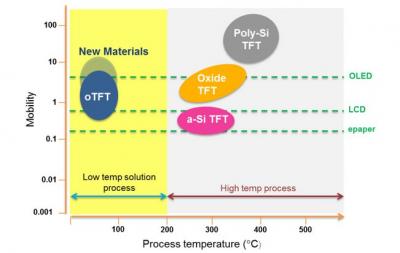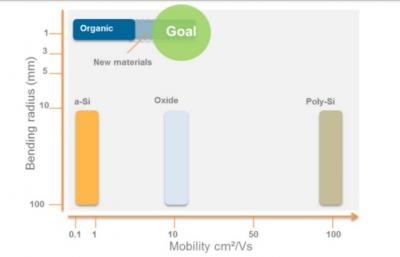 A few weeks ago I posted about Plastic Logic's OTFT-based AMOLED demonstration. While the company's current demo is a simple display (monochrome white), it seems that Plastic Logic believes that OTFT technology is now reaching a performance level for adoption in AMOLED displays.
A few weeks ago I posted about Plastic Logic's OTFT-based AMOLED demonstration. While the company's current demo is a simple display (monochrome white), it seems that Plastic Logic believes that OTFT technology is now reaching a performance level for adoption in AMOLED displays.
I discussed this with Mike Banach, Plastic Logic's Research Director. Mike (and the rest of the team at PL too, of course) says that organic semiconducting materials have reached a "tipping point" in electrical performance that makes them viable to drive flexible OLED displays. Couple this with the industrial and flexibility benefits of using solution-based organic materials makes it a compelling technology option for display makers looking to establish a position in the flexible display market.

OTFT are very promising as flexible OLED backplanes because they are processed at low temperatures (below 100 degrees Celsius) and they are more flexible compared to silicon or oxide-TFT backplanes. Traditionally OTFT materials suffered from low mobility which meant they couldn't' be used for OLED displays. But performance has been improving constantly in past years.

In fact, Mike says that the mobility of those organic materials improved by a factor of 1 million over the past 25 years, and it keeps getting better. For example, a recent article reported a mobility of 43 cm2/Vs for an organic transistor. Mike says that today’s commercially available organic semiconductors have a mobility performance in the range of 1-5 cm2/Vs, which is enough to drive a wide range of AMOLED displays. He suspects that the recent successes reported in the academic literature will take a few years to reach industrial production, but there is now a clear roadmap to mobilities approaching 10 cm2/Vs, which will enable the production of high pixel density, large area displays.
The actual mobility needed to drive an OLED display depends on the TFT uniformity, stability, power dissipation and other factors - and this means that it is difficult to actually say what is the mobility requirements of OLEDs in general. Mike says that current OTFT mobilities of about 1 to 5 Cm2/Vs are enough to drive some OLED displays, and now it's possible to consider real application with such performance.
So now we're waiting for Plastic Logic and other players to actually introduce this technology to the OLED industry. The company plans to produce a series of new demonstrators and advance the technology in 2014. I guess that even optimistically, OTFTs won't be adopted commercially in OLED displays for a couple of years yet. But down the road, OTFT may enable truly flexible, cheaper OLED panels.

